
USS Quincy (CL/CA-39) was a United States Navy New Orleans-class cruiser, sunk at the Battle of Savo Island in 1942.

USS De Haven (DD-469) was a Fletcher-class destroyer of the United States Navy, the first Navy ship named for Lieutenant Edwin J. De Haven USN (1819–1865). De Haven was the first Fletcher-class ship lost in World War II, having been in commission only 133 days.
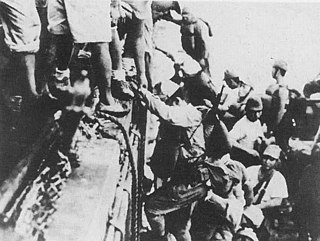
The Tokyo Express was the name given by Allied forces to the use of Imperial Japanese Navy ships at night to deliver personnel, supplies, and equipment to Japanese forces operating in and around New Guinea and the Solomon Islands during the Pacific campaign of World War II. The operation involved loading personnel or supplies aboard fast warships, later submarines, and using the warships' speed to deliver the personnel or supplies to the desired location and return to the originating base all within one night so Allied aircraft could not intercept them by day.

The Battle of Cape Esperance, also known as the Second Battle of Savo Island and in Japanese sources as the Sea Battle of Savo Island (サボ島沖海戦), took place on 11–12 October 1942, in the Pacific campaign of World War II between the Imperial Japanese Navy and United States Navy. The naval battle was the second of four major surface engagements during the Guadalcanal campaign and took place at the entrance to the strait between Savo Island and Guadalcanal in the Solomon Islands. Cape Esperance (9°15′S159°42′E) is the northernmost point on Guadalcanal, and the battle took its name from this point.

The Russell Islands are two small islands, as well as several islets, of volcanic origin, in the Central Province of Solomon Islands. They are located approximately 48 kilometres northwest of Guadalcanal. The islands are partially covered in coconut plantations, and have a copra and oil factory at Yandina. Yandina also has basic services, including a store, post office, and airport.

Operation Ke was the largely successful withdrawal of Japanese forces from Guadalcanal, concluding the Guadalcanal Campaign of World War II. The operation took place between 14 January and 7 February 1943, and involved both Imperial Japanese Army (IJA) and Imperial Japanese Navy (IJN) forces under the overall direction of the Japanese Imperial General Headquarters (IGH). Commanders of the operation included Isoroku Yamamoto and Hitoshi Imamura.

During World War II, Operation Cleanslate was the occupation of Russell Islands about sixty miles northwest of Guadalcanal by the United States on 21 February 1943. The Japanese had captured the islands in January 1943 but abandoned them after only two weeks. A coastwatcher reported on 11 February that Japanese forces had left the islands.
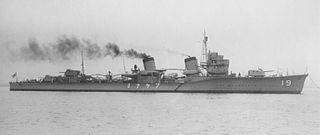
Ayanami was the eleventh of twenty-four Fubuki-class destroyers, built for the Imperial Japanese Navy following World War I. When commissioned, these ships were the most powerful destroyers in the world. They served as first-line destroyers through the 1930s, and remained formidable weapons systems well into the Pacific War.

Santa Isabel is the largest island in Isabel Province, Solomon Islands. It is also the longest island, with the third largest surface area, in the country.

Akatsuki was the twenty-first Fubuki-class destroyer, or the lead ship of the Akatsuki class, built for the Imperial Japanese Navy in the inter-war period. When introduced into service, these ships were the most powerful destroyers in the world. They remained formidable weapons systems well into the Pacific War.

Yūdachi was the fourth of ten Shiratsuyu-class destroyers built for the Imperial Japanese Navy under the "Circle One" Program.
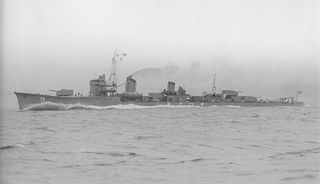
Natsugumo was the seventh of ten Asashio-class destroyers built for the Imperial Japanese Navy in the mid-1930s under the Circle Two Supplementary Naval Expansion Program.

Takanami (高波) was a Yūgumo-class destroyer of the Imperial Japanese Navy. Her name means "Tall Wave".
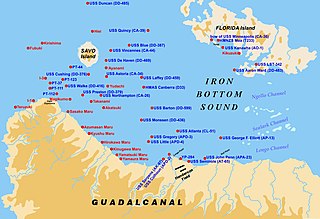
Cape Esperance is the northernmost point on Guadalcanal, Solomon Islands.

The Matanikau River of Guadalcanal, Solomon Islands, is located in the northwest part of the island. During the World War II Guadalcanal campaign, several significant engagements occurred between United States and Japanese forces near the river.

Tassafaronga Point is a point on the north shore of Guadalcanal, Solomon Islands. The Battle of Tassafaronga, one of several naval engagements fought in the waters north of the island during the World War II Guadalcanal Campaign, took its name from this point.

The Guadalcanal American Memorial is a World War II monument on Guadalcanal in Solomon Islands. Dedicated on August 7, 1992, it was established as a tribute to the Americans and their allies who lost their lives during the Guadalcanal Campaign from 7 August 1942 to 9 February 1943. The capital city of Honiara is to its north. To mark the 50th anniversary of the Red Beach landings, the U.S. War Memorial was dedicated on 7 August 1992. An account of this is also inscribed on red marble tablets inside the monument compound. The memorial was a joint effort of the American Battle Monuments Commission (ABMC) and the Guadalcanal-Solomon Islands Memorial Commission, and was at the initiative of Robert F Reynolds, Chief of Valors Tours Ltd. The memorial is maintained by the ABMC. Every year on 7 August, a commemorative ceremony is held to mark the first day of the battle. Another monument, erected by the Japanese on Mount Austen, is a tribute to the Japanese who lost their lives.
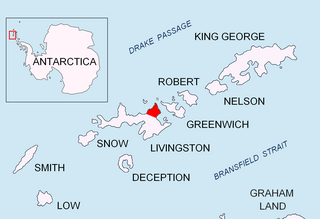
Dlagnya Rocks are the several contiguous rocks in Zed Islands off Varna Peninsula, Livingston Island in the South Shetland Islands extending 540 m in north-south direction and 60 m wide. The area was visited by early 19th century sealers.
The Diocese of Guadalcanal is one of the nine current dioceses of the Anglican Church of Melanesia. It was founded on 23 June 2013.
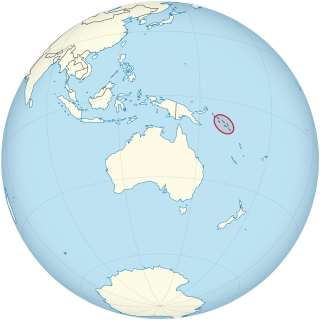
US Naval Base Solomons was a number of United States Navy bases in the Solomon Islands in the Pacific Ocean. Most were built by the US Navy Seabees, Naval Construction Battalions, during World War II as part of the Pacific War. In August 1942 the United States Armed Forces took the Guadalcanal in the Solomon, in the Battle of Guadalcanal. US Navy Seabees built a new base at Guadalcanal, Naval Base Guadalcanal and then on other islands in the Solomons.

















